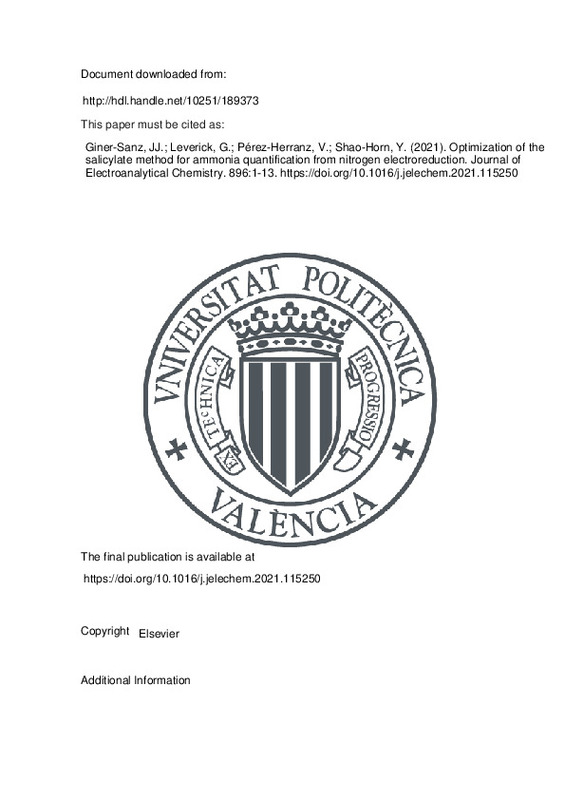JavaScript is disabled for your browser. Some features of this site may not work without it.
Buscar en RiuNet
Listar
Mi cuenta
Estadísticas
Ayuda RiuNet
Admin. UPV
Optimization of the salicylate method for ammonia quantification from nitrogen electroreduction
Mostrar el registro sencillo del ítem
Ficheros en el ítem
| dc.contributor.author | Giner-Sanz, Juan José
|
es_ES |
| dc.contributor.author | Leverick, Graham
|
es_ES |
| dc.contributor.author | Pérez-Herranz, Valentín
|
es_ES |
| dc.contributor.author | Shao-Horn, Yang
|
es_ES |
| dc.date.accessioned | 2022-11-07T19:01:30Z | |
| dc.date.available | 2022-11-07T19:01:30Z | |
| dc.date.issued | 2021-09-01 | es_ES |
| dc.identifier.issn | 1572-6657 | es_ES |
| dc.identifier.uri | http://hdl.handle.net/10251/189373 | |
| dc.description.abstract | [EN] The salicylate method is one of the colorimetric methods that is used for ammonia quantification in nitrogen (electro)fixation. While the salicylate method offers advantages in that it avoids working with toxic reagents and does not generate toxic fumes, ammonia quantification is sensitive to the exact experimental conditions (e.g. color development time, exposure to light, etc.) and to a number of interferences (e.g. pH of the samples, presence of interferents, etc.), which leads to reproducibility problems. In this work, the influence of different factors on the ammonia quantification in Nitrogen Reaction Reduction (NRR) using the salicylate method was examined, both in aqueous media and in non-aqueous media. The detailed experimental procedures presented in this work, provide an optimized reference method for quantifying ammonia in NRR screening experiments using the salicylate method. | es_ES |
| dc.description.sponsorship | This work was supported by the Toyota Research Institute through the Accelerated Materials Design and Discovery program. This work made use of the MRSEC Shared Experimental Facilities at MIT (SEM) supported by the National Science Foundation under award number DMR-1419807 as well as the HZDR Ion Beam Center TEM facilities. J.J.G.S. is very grateful to the Generalitat Valenciana and to the European Social Fund, for their economic support in the form of Vali+d postdoctoral grant (APOSTD-2018-001). G.M.L. was partially supported by a Natural Sciences and Engineering Research Council of Canada (NSERC) PGS-D and a Siebel Scholarship (Class of 2020). | es_ES |
| dc.language | Inglés | es_ES |
| dc.publisher | Elsevier | es_ES |
| dc.relation.ispartof | Journal of Electroanalytical Chemistry | es_ES |
| dc.rights | Reconocimiento - No comercial - Sin obra derivada (by-nc-nd) | es_ES |
| dc.subject | Ammonia quantification | es_ES |
| dc.subject | Aqueous samples | es_ES |
| dc.subject | Nitrogen reduction reaction | es_ES |
| dc.subject | Non-aqueous samples | es_ES |
| dc.subject | Salicylate method | es_ES |
| dc.subject | UV-visible spectroscopy | es_ES |
| dc.title | Optimization of the salicylate method for ammonia quantification from nitrogen electroreduction | es_ES |
| dc.type | Artículo | es_ES |
| dc.identifier.doi | 10.1016/j.jelechem.2021.115250 | es_ES |
| dc.relation.projectID | info:eu-repo/grantAgreement/NSF//DMR-1419807/ | es_ES |
| dc.relation.projectID | info:eu-repo/grantAgreement/GVA//APOSTD%2F2018%2F001//Contratación investigador postdoctoral GVA - Giner Sanz. Proyecto: una batería de flujo REDOX para la valorización energética del co contenido en el bio/ | es_ES |
| dc.rights.accessRights | Abierto | es_ES |
| dc.description.bibliographicCitation | Giner-Sanz, JJ.; Leverick, G.; Pérez-Herranz, V.; Shao-Horn, Y. (2021). Optimization of the salicylate method for ammonia quantification from nitrogen electroreduction. Journal of Electroanalytical Chemistry. 896:1-13. https://doi.org/10.1016/j.jelechem.2021.115250 | es_ES |
| dc.description.accrualMethod | S | es_ES |
| dc.relation.publisherversion | https://doi.org/10.1016/j.jelechem.2021.115250 | es_ES |
| dc.description.upvformatpinicio | 1 | es_ES |
| dc.description.upvformatpfin | 13 | es_ES |
| dc.type.version | info:eu-repo/semantics/publishedVersion | es_ES |
| dc.description.volume | 896 | es_ES |
| dc.relation.pasarela | S\453322 | es_ES |
| dc.contributor.funder | Generalitat Valenciana | es_ES |
| dc.contributor.funder | Toyota Research Institute | es_ES |
| dc.contributor.funder | National Science Foundation, EEUU | es_ES |
| dc.contributor.funder | Natural Sciences and Engineering Research Council of Canada | es_ES |







![[Cerrado]](/themes/UPV/images/candado.png)

